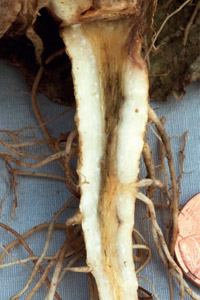cemchris
Supporter
- 3,346
- 263
But are either necessary in a buffered soil? Personally I think having to add either is a soil problem or source water issue.
Thoughts?
Yeah proper soil shouldn't have any of those concerns. I am by no means a soil guy just a nute guy so prob not the best person to school on that. NH4/N03 has a big affect on soil PH tho and the micro breaking it down.
How the Ammonium-nitrate ratio affects your plants | CANNA Gardening USA
In this article, we are going to look specifically at the effect of the ammonium/nitrate ratio and its effect on the growth and development. Read more >

Figure 3: This lettuce root is discoloured
because of ammonium toxicity. Ammonium
toxicity occurs when soils are cool and the
soil surface is sealed or compacted, resulting in
slow nitrification rates. This disorder can also occur in
fields with poorly drained, waterlogged soils.
The use of fertilizers that contain ammonium can
contribute to ammonium toxicity as well.
As explained earlier, ammonium uptake usually makes the soil pH in the root zone fall, while nitrate uptake raises the soil pH. Under certain conditions, however, the pH may not respond as expected due to microbial activity around the roots. Most of the processes that involve ammonium and nitrate are part of the nitrogen cycle (figure 2). The most important step is the biological oxidation of ammonium to nitrate, known as nitrification. This process consists of various steps and is mediated by autotrophic, obligate aerobic bacteria, meaning that oxygen is required. The plants take up their nitrogen source as nitrate rather than ammonium, effectively increasing the pH in the rooting zone.
The nitrification process can easily be disturbed, and such disturbances usually result in ammonium accumulation in the soil. One of the causes is a low soil pH, which limits the nitrogen conversion by depressing the microbial oxidation of ammonium.
Secondly, as mentioned earlier, converting ammonium to nitrate in the soil requires oxygen. In very wet soils, the air content drops which often means less oxygen available in the soil. In the absence of oxygen, microbial activity is usually low, meaning less ammonium is converted to nitrate and an accumulation of ammonium.
The soil micro-organisms need organic matter (dead plant material, humus) as a source of carbon. In poor soils with little organic matter like sandy soils, microbial growth and thus nitrification is limited. A low soil temperature can also depress nitrification, due to low soil micro-organism activity.
hey dirtbag thanks for the tip.. im a bit confused when it comes silicate, silicon, silicic acid ... is it all the same? I mean i use silicon or silicate ( aptus regulator ) to improve the plants immune system, aparently it makes the cell´s wall thicker, makes them resistent to pests and high temperatures, and controls the internode distance so they dont strectch excesively,, is that what potassium silicate does apart from helping to buffer the Ph?
It's all the same. Different sources. Paying way more for some sources but plants only uptake it in 1 form. Don't buy into the marketing for paying $120+ for a bottle of Si.
Here is a read on it. Getting Agsil-16 is your best bet. If you want to buy bottled don't waste your money on Aptus or OSA ect and just get Pro-tekt from Dynagro
Soluble Silicon Fertilizer Comparison
Soluble Silicon Fertilizer Comparison
customhydronutrients.com





